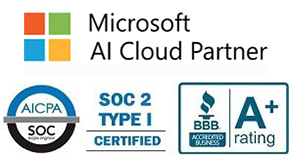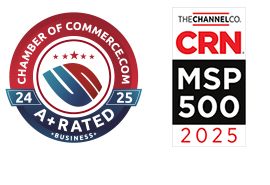IT Consulting | IT Support | Managed Services | New Jersey Computer Support Services

Business owners are under constant pressure to manage complex technology needs while staying compliant with evolving security standards. Maintaining trust with employees, stakeholders, and clients depends on getting both right.
With a trusted, experienced partner like ICS, businesses can streamline their IT strategy and compliance efforts into one cohesive approach, ensuring protection and performance for long-term success.
IT Strategy and Compliance: Understanding the Connection
Before you can align your IT strategy with your compliance goals, it’s crucial to understand the role each one plays in your business and where the two intersect.
IT Strategy
An IT strategy outlines how technology supports your business goals. It identifies processes, tools, and frameworks to optimize productivity, improve scalability, and enhance customer satisfaction. At its core, an IT strategy keeps your organization competitive and forward-focused through the careful, intentional use of technology.
IT Compliance
IT compliance regulations outline measures businesses are expected to take to protect data effectively and responsibly use technology. They vary from industry to industry, but here's a look at some of the most common frameworks you should be familiar with:
-
HIPAA governs the protection and accessibility of sensitive health data.
-
CMMC focuses on safeguarding information for organizations working with the U.S. Department of Defense.
-
SOC 2 is a widely accepted standard for managing customer data to protect privacy, security, and availability.
-
GDPR outlines how personal data should be collected, stored, and transferred.
The Overlap
Compliance regulations often require technology and security measures that benefit businesses beyond just meeting standards. For example, data encryption, access controls, and system monitoring are mandated by frameworks such as HIPAA and CMMC, but they are also key strategies for mitigating data breaches.
Aligning your IT strategy with compliance requirements means these controls will be integrated by design, making both processes more effective and efficient.
The Importance of a Unified Assessment
The first step in harmonizing IT and compliance is running a comprehensive assessment of both areas. Start by analyzing your existing IT infrastructure for alignment with current compliance obligations. Identify tools, software, and practices that help meet regulatory requirements or pose risks.
Running this assessment with an eye for both general strategy and compliance will help you avoid common vulnerabilities that tend to emerge when both areas operate in isolation, such as minimal security that meets operational requirements but violates compliance protocols.
A unified assessment also ensures that your teams and specialists are communicating with each other and can work together to meet compliance requirements and operational needs. This bigger, clearer picture of your technology will be key to your success and security.
Creating an Integrated IT-Compliance Roadmap
With insights from your assessment in hand, it's time to create a strategic plan to close gaps and reinforce what’s already working. Collaborate closely with your IT and compliance teams, and be sure to engage key stakeholders. Their involvement is crucial for aligning with broader business objectives and securing the support and resources needed for smooth implementation.
The exact steps for creating this roadmap will vary from company to company, but this basic outline can give you an idea of what the process might look like:
-
Make a detailed, organized list of key compliance and general IT needs that need to be met.
-
Organize your list from most to least important, prioritizing items that have a deadline (such as requirements for a compliance audit) and those that will meet both compliance and IT strategy needs.
-
Make specific plans for implementing each item, including timelines, goals, and any hardware, software, or external support you'll need.
Security Measures that Meet Compliance Standards
The beauty of combining security with compliance is that many of the controls you already include as part of your proactive cybersecurity approach meet compliance requirements. Even if additional procedures are needed, your systems will already be set up to handle advanced cybersecurity measures, making the compliance process smoother.
Let's go over a few essential security controls that can work double time as best cybersecurity practices and compliance efforts:
-
Encryption: Encoding your data and messages is a foundational way to keep your business data private, and advanced encryption is required for standards like CMMC and SOC 2.
-
Access Controls: Multi-factor authentication (MFA), the principle of least privilege, and other common access control strategies ensure sensitive systems are available only to those who need them, and are also a key category of CMMC and other regulations.
-
Network Monitoring: Proactive monitoring allows you to track and catch suspicious activity early on and comply with standards like CMMC, HIPAA, and SOC II.
-
Employee Training: Security awareness training is one of the most effective ways to protect your technology, which is why it's a common requirement for most compliance frameworks, including CMMC, HIPAA, SOC II, GDPR, and more.
Building a Culture of Continuous Compliance
Completing your assessment and creating your roadmap are only the beginning. To maintain effective compliance and security, build a culture of compliance and engage in continuous efforts to stay secure. Here are a few things you can prioritize to help promote ongoing security and compliance throughout your organization.
Training and Awareness Programs
Your employees can provide some of the most valuable protection against threats and support for compliance initiatives. Equip them with the knowledge and skills they need through regular training on compliance updates and cybersecurity best practices.
Regular Audits and Policy Updates
Perform regular audits to ensure your IT systems are still secure and compliant with evolving regulations. Update policies frequently to reinforce a commitment to compliance across departments and keep up with any changes to regulations.
Leadership Support
Encourage leaders to promote a compliance-first culture. When business leaders champion security and compliance efforts, teams are more likely to prioritize them in daily operations.
Expert Consultants
Compliance and IT strategies can get complicated quickly, but having a professional team like ICS on your side can make them simple. Through comprehensive managed cybersecurity and compliance services, we'll help you stay on track through any changes in your business or industry regulations.
ICS: Unifying IT Strategy and Compliance for the Better
Aligning your IT strategy with your compliance efforts is most effective when you have the expertise, tools, and support needed to tackle each issue with confidence. When you partner with ICS, that's exactly what you'll get. Schedule your IT assessment to see our services in action and unify your IT efforts.
SCHEDULE AN IT Assessment
About Us:
- 150+ 5-Star Google Rated IT Firm
- Microsoft Certified Cloud AI Partner
- SOC II Certified Managed Service Provider
- Better Business Bureau A+ Rated






